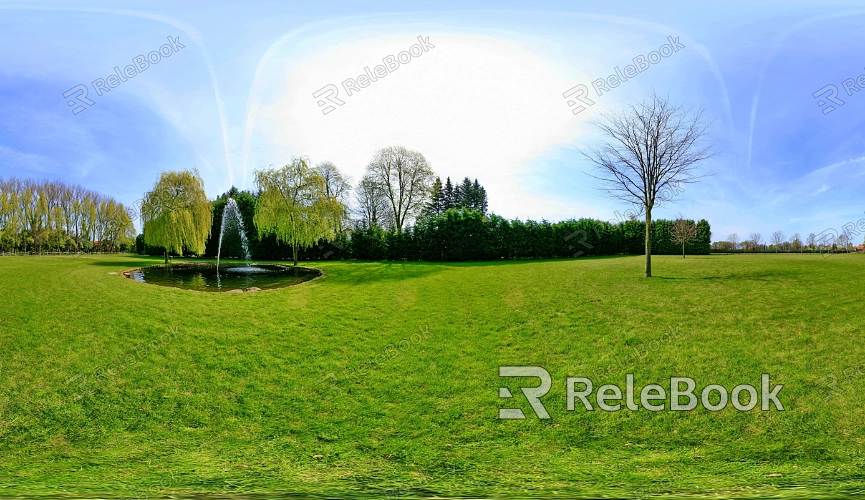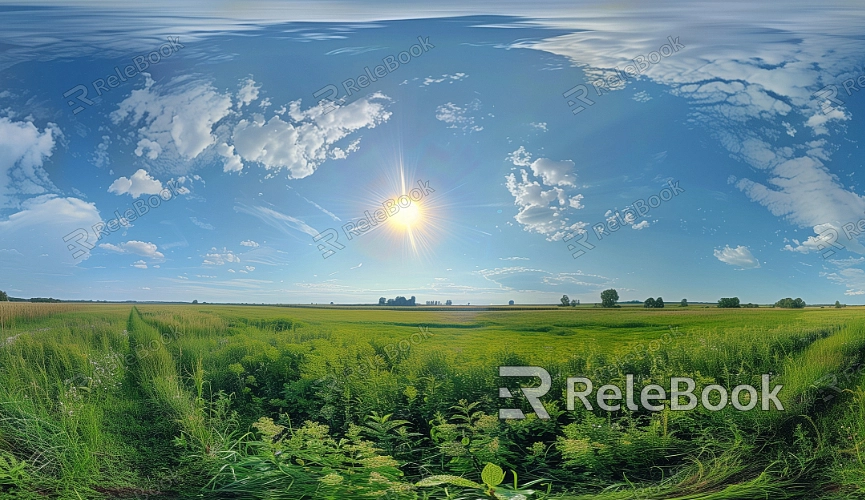Can Grass Texture HDR Improve Outdoor Scene Realism
In 3D modeling and rendering for outdoor scenes, designers frequently face the challenge of enhancing the realism of grass textures. Whether it's for architectural visualization, game environments, or animation projects, achieving realistic lighting and shadows is critical for creating an immersive scene. This is where HDR (High Dynamic Range) textures come into play. By using HDR files, designers can capture and replicate the intricate lighting and shadow details found in natural settings, significantly improving the realism of grass textures. In this article, we'll explore how grass texture HDR contributes to enhancing outdoor scene realism and how to effectively use these techniques in 3D software like 3ds Max, Blender, and Cinema 4D.

1.How HDR Textures Improve Lighting Effects
HDR textures capture lighting information under various exposure levels, providing a much broader dynamic range than traditional textures. When applied to grass textures, HDR files simulate subtle lighting changes in natural environments, such as the transition of shadows during sunrise or sunset. Designers can use HDR lighting to capture the reflection and shadow effects of sunlight on grass, boosting the realism of outdoor scenes.
Dynamic Range Advantage: Compared to standard textures, HDR files contain richer brightness and contrast information, helping grass display more natural light and shadow under different lighting conditions.
Uniform Lighting: HDR lighting ensures that the grass surface doesn't develop unnatural highlights or dark spots, which is especially useful for large grass-covered areas where the lighting appears softer and more even.
2.Recommended 3D Software and Rendering Engines
Popular 3D software such as 3ds Max, Blender, and Cinema 4D all support the import and application of HDR textures. Paired with powerful rendering engines like VRay, Corona, or Cycles, these software tools allow designers to fully leverage HDR lighting for grass textures. With these software systems’ advanced lighting tools, designers can flexibly adjust the exposure, intensity, and angle of HDR files to achieve the desired effect.
VRay Dome Light: In 3ds Max, VRay Dome Light allows HDR files to be loaded, enabling designers to control grass lighting by adjusting intensity and exposure.
Corona Renderer: When using the Corona renderer, combined with the Corona Sun & Sky system, designers can fine-tune the lighting of grass at different times of day for more precise control.
3.Optimizing Grass Reflection and Light Interaction
The realism of grass textures depends not only on the lighting intensity but also on their reflective properties. In real life, grass has low reflectivity, especially under direct sunlight, so excessive reflection would appear unnatural. By adjusting the reflectivity settings, designers can avoid overly bright areas on the grass surface, enhancing its realism.
Controlling Reflectivity: Reducing the reflectivity of the material will result in grass that responds more naturally to lighting conditions.
Lighting Models: Using physically-based lighting models allows for a more accurate simulation of light interaction with the grass surface, ensuring that shadows and light distribution look natural.
The Impact of HDR File Resolution on Grass Detail
Achieving fine lighting details on grass requires high-resolution HDR files. Low-resolution HDR textures may cause loss of surface details on the grass, which can affect the final rendering outcome. Designers should choose HDR files with the appropriate resolution based on the needs of their scene to ensure enough detail is captured.
Benefits of High-Resolution HDR: In large-scale grass scenes, high-resolution HDR files capture more light variations and shadow details, improving the overall immersion of the scene.
Resolution vs. Performance: While higher-resolution HDR files enhance visual quality, they can also increase rendering times. Finding the right balance between performance and quality is essential.

5.Combining Grass HDR with Ambient Occlusion
To further enhance the details of the grass texture, designers can combine HDR lighting with Ambient Occlusion (AO) techniques. AO simulates shadowing in areas where light is less direct, adding more depth and detail to the grass, making the entire scene feel more three-dimensional and realistic.
Using AO Effectively: Applying AO maps to grass textures helps enhance shadow details, particularly in scenes with softer lighting.
HDR and AO Synergy: Combining HDR with AO allows for more precise reproduction of subtle lighting changes, especially in complex grass environments, significantly boosting overall realism.
6.The Necessity of Adjusting HDR Lighting Angles
The angle of the light source can have a significant effect on grass textures. Sometimes, the default HDR lighting angle might not suit the needs of the current scene. In such cases, designers can rotate the HDR file to adjust the light source position, optimizing the lighting effect. For example, changing the light direction can create different shadow distributions, making the grass appear more natural.
Optimizing Light Direction: By adjusting the HDR lighting angle, designers can simulate sunlight shining on the grass from specific directions, such as during sunrise or sunset.
Avoiding Unnatural Highlights: Rotating the HDR angle helps to prevent harsh reflections from certain angles on the grass surface.
7.HDR's Role in Grass Texturing for Night Scenes
In certain specialized scenes, such as nighttime or low-light environments, HDR lighting can still play a crucial role. By adjusting the exposure and intensity of the HDR file, designers can create soft, natural-looking grass textures under low lighting conditions.
Nighttime HDR Settings: Lowering the brightness of HDR lighting can simulate moonlight or artificial lighting on grass, making night scenes more realistic.
Combining Emissive Properties with HDR: In night scenes, designers can also add emissive effects to the grass textures, creating a unique atmosphere.
Through this article, we've explored the various ways grass HDR textures can be applied in 3D scenes and how they enhance the realism of outdoor environments. From basic lighting setups to fine-tuning reflective properties, HDR textures provide designers with an extensive set of tools to adjust lighting and shadows with precision. If you're looking for high-quality HDR textures or other 3D assets, the Relebook platform offers a wide selection of resources to help you achieve outstanding visual results in your projects.

